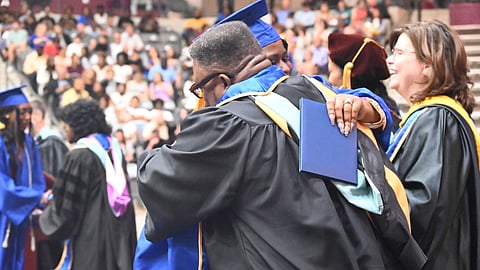
- Home
- Topic Areas
- Newsletter
- Podcast
- 100 Families Initiative
- About
- Connect
- Restore Hope

The North Little Rock Academy provides an alternative learning environment in the North Little Rock School District, serving students in grades six through twelve. An alternative education academy is a type of educational institution designed to meet the needs of students who may not thrive in traditional school settings. These academies offer tailored approaches to learning and serve at-risk youth who have experienced trauma, homelessness, or other significant life challenges. They may be behind on their credits, have difficulties in social settings, or have children at a young age.
Sandy Williams, the director of North Little Rock Academy, explains that the school tries to identify a student’s needs, set goals, and come up with a timeline for getting back to a traditional school setting. The goal is to get them back on track toward graduation. Williams works to connect his students and their families with support services to address the challenges that may be hindering their education.
Many of his students have already encountered the juvenile justice system because of behavioral issues they experienced while in a traditional school environment. It’s been a rewarding journey for him, seeing kids graduate from high school and some from college. He loves the idea of getting to be a positive role model in someone’s life.
Alternative education academies also support students with responsibilities beyond the classroom. Several students are forced to get a job so their families can make ends meet. Williams helps them juggle both school and employment, sometimes negotiating with their employers so they can balance working with pursuing their studies.
Williams says his work often involves a multigenerational approach. “Unfortunately sometimes we find ourselves not only having to parent the child but also having to parent the parent. Sometimes our work involves three generations.”
For example, a household lacking structure, discipline, or a caretaker can enable a student to stay out all night and miss out on crucial hours of sleep needed to pay attention in school.
Williams says he sees success stories every day and would like a greater focus on financially supporting education for at-risk students, especially since sending a troubled youth to a detention facility comes with a price tag of $320/day. “I believe that education is a pathway to progress and to victory.”
He hopes to see more community programs that teach both kids and their parents to read, as well as increased outreach to young children who are at high risk for future incarceration due to their life circumstances. “We can make great strides in education. And we can turn things around for our kids just by doing that.”
Higher levels of educational attainment are generally associated with lower crime rates, Williams points out. Education can provide individuals with the skills and opportunities needed for stable employment, reducing the economic incentives for engaging in criminal behavior. “Crime comes when people feel like they don’t have the necessities or another means of getting necessities. There are some well-educated people in prison, but that is not the general population.”
Williams supports the need to reform discipline practices in traditional school environments. He thinks suspending students and sending them home can make the situation worse. School provides children with structure, he says, and if they are home alone while parents are working or elsewhere, these children will likely get in trouble. “Don’t assign them to their home; assign them to an intervention program.”
Many students are looking for a sense of belonging, so sending them home could make them feel even more isolated. “If a kid doesn’t know that you care, then what you have to say to them won’t matter.”
Williams also believes in providing children with year-round opportunities for education to reduce learning loss. He adds that year-round education can be beneficial for working parents by providing a more consistent schedule for child care and a safe place for kids. “Kids can learn. With the right setting, they will learn. We just have to pour into them.”
Growing up in neighborhoods plagued by gang activity, domestic abuse, or frequent criminal incidents, young people may adopt violent behaviors to protect themselves or to fit in with their peers. This environment can create a cycle where violence begets more violence, as each new generation of youth becomes accustomed to living in a world where aggression and brutality are the norms.
While Williams sees many success stories, the stories of kids he tried to help but could not weigh heavy on his mind. “You see kids and they don’t make it. And then you have to go to a funeral or you are writing a letter to a student who will be spending the rest of their life in prison. This work can be heart-breaking.”
Without positive role models or intervention programs to provide alternatives, Williams says, these young individuals are at risk of continuing the cycle of violence into adulthood.
“I believe we can have a positive impact on kids and families. The opportunity to act is right now. A lot of good things happen for kids, but they seem to happen in pockets. When we bring organizations helping kids together, on a larger scale, everyone can connect and know what’s going on with the kids. I think that helps families. I think that’s a great thing.”
Related Stories:
Smart Justice is a magazine, podcast, and continuing news coverage from the nonprofit Restore Hope and covers the pursuit of better outcomes on justice system-related issues, such as child welfare, incarceration, and juvenile justice. Our coverage is solutions-oriented, focusing on the innovative ways in which communities are solving issues and the lessons that have been learned as a result of successes and challenges.
The podcast is available on all major podcasting platforms.
Subscribe to the Smart Justice newsletter.
